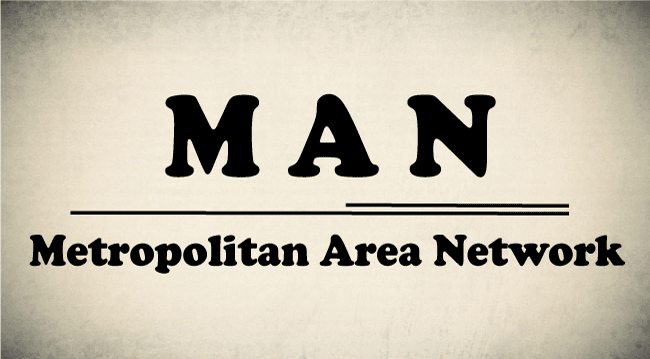What is the full form of MANMAN: Metropolitan Area NetworkMAN stands for Metropolitan Area Network. The acronym is Metropolitan Area Network. It is a computer system that links multiple local-area networks (LANs) to form a larger network that allows for sharing of computer resources. This kind of network has a wider coverage area than a LAN, but it is still less than a WAN, which is meant to cover a whole city. MAN is specifically made to give consumers access to high-speed connectivity with a range of Mbps speeds. The MAN's intricate architecture makes it difficult to create and keep up with. MAN is between WAN and LAN in size. The scope and scale of the various computer designs can be used in networking as a classification method. Area network types frequently include LAN, WLAN, WAN, SAN, PAN, CAN, DAN, & MAN. 
In this article, we will solely discuss MAN in its complete form and its benefits and drawbacks. MAN is positioned among LAN and WAN since it is larger than LAN and less significant than WAN. It includes a city's underground area network. What Does MAN Stand for in Computer Language?In computer networking, the MAN is formally known as Metropolitan Area Network. A MAN could be a single network, similar to the cable television network. Still, it typically connects numerous LANs using high-capacity backbone technologies, including fiber-optic cables and offers up-link services to a WAN. Between five and several hundred miles in length, MAN travels at speeds between 1.5 and 10 Mbps. Examples of MANs are FDDI (Fiber Distribution Data Transfer) and ATM (MAN full name: Metropolitan Area Network) (Asynchronous Transfer Mode). How Are MAN Networks Constructed?Similar to WANs, a MAN is composed of interconnected LANs. Since data does not need to travel long distances, MANs are typically more efficient than WANs. Instead of being run by a single organization, MANs often combine the networks of several different organizations. The majority of MANs connect LANs via fiber optic lines. A MAN frequently uses "black fiber"-traffic-carrying fiber optic cables previously idle. Leasing these fiber optic lines from private Internet service providers is an option (ISP). A city government may construct and maintain a metropolitan fiber optic network before leasing dark fiber to private businesses in particular instances. Background of MANTo link LANs when they were first established in 1994 to allow data connectivity in buildings and offices, enterprises mostly relied on mobile switching telephone networks. The telephone network, however, could not handle that amount of traffic. To address this issue, it was suggested that LANs be linked via single-mode fiber optic lines, creating metropolitan area networks (MAN) to connect LANs efficiently. These fiber optic MANs are run and owned by private companies or organizations, and they may not have been completely integrated through gateways with the public wide area network (WAN). MAN CharacteristicsThe characteristics of MAN include;
Benefits of MAN (Metropolitan Area Network)In terms of area network coverage, MAN outperforms LAN and is in the middle of LAN and WAN. Let's go over the benefits of the MAN in more detail. The advantages are as follows:
The Drawbacks of MAN (Metropolitan Area Network)Each network design has advantages and disadvantages. We know its excellent coverage of the entire city and continued network connectivity. Let's now examine its drawbacks. The drawbacks are as follows:
MAN examples include
Next TopicFull Form
|
 For Videos Join Our Youtube Channel: Join Now
For Videos Join Our Youtube Channel: Join Now
Feedback
- Send your Feedback to [email protected]
Help Others, Please Share










